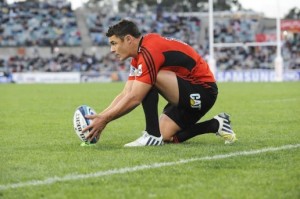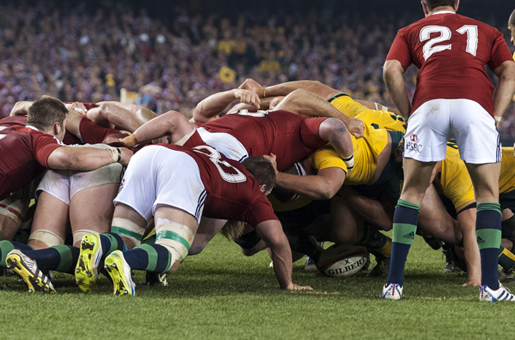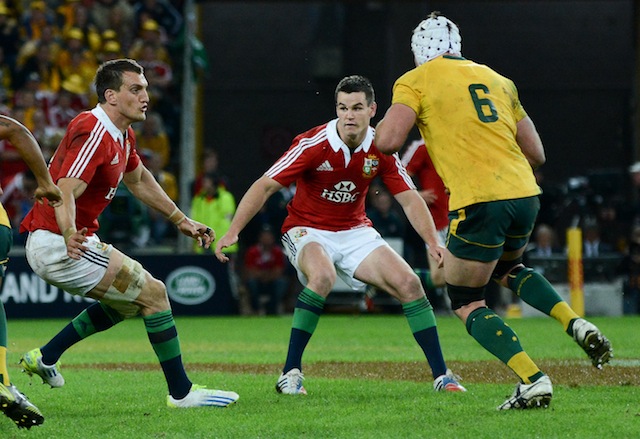1. Will the scrum hold?
The million dollar question. With Craig Joubert reffing and a new scrum engagement, Ewen McKenzie might have his hand forced on his selection of props: he has to pick those who he thinks won’t cost the team scrum penalties. Joubert likes a good scrum and isn’t afraid to use the whistle. But here’s the stat you’ll have in your head to tell the guy on the barstool next to you as the anthems are playing: in Super Rugby this year, Craig Joubert penalised the away team 81 times, and the home team only 66 times. Almost two extra penalties per game. This isn’t a pattern representative of refereeing in general this season.
There isn’t a huge amount of variation in the number of penalties (scrum and non-scrum) conceded by each of the props in the extended Wallaby squad per 80 minutes (though from outside the squad, Greg Holmes conceded twice as many as the top echelon). Where there is variation is in the other aspects of prop performance that together comprise “work rate.”
| Runs per 80 minutes | Metres per run | First into rucks per 80 minutes | Tackles Attempted per 80 minutes | Tackles Missed | Penalties Conceded per 80 minutes | |
|---|---|---|---|---|---|---|
| Ben Alexander | 5.78 | 2 | 5.31 | 8.35 | 1.01 | 1.4 |
| Scott Sio | 5.71 | 4 | 5.42 | 8.77 | 1.38 | 0.99 |
| Sekope Kepu | 4.12 | 3 | 3.3 | 12.02 | 0.94 | 0.59 |
| Benn Robinson | 5.74 | 3 | 5.74 | 8.34 | 0.82 | 0.74 |
| James Slipper | 7.02 | 2 | 6.6 | 12.08 | 0.91 | 0.63 |
| Paddy Ryan | 8.36 | 4 | 7.03 | 9.55 | 1.06 | 1.33 |
Not all things are equal. The Reds love a pick-and-drive – they did so almost ten times as often as the Tahs this year – so James Slipper’s runs per metre are going to be a bit down. Similarly, Paddy Ryan played a lot off the bench, so you’d expect him to have a bit higher work rate than the others.
But there is still a clear pattern there. It’s easier to see now why Benn Robinson got omitted in the final cut in favour of Slipper and Sio, both in terms of performance this year and in terms of future potential. Of note also is that Alexander used to be the model for the mobile prop, but since he’s focused on tighthead duties alone and bulked up his work rate has come back to the rest of the pack. Fantasy rugby players would know that.
The point is that McKenzie will have these figures, so will Steve Hansen, and he’ll be weighing up whether a guy like James Slipper can give enough in the scrum to justify the selection that his Super Rugby numbers merit. 0.63 penalties conceded per match (again, inclusive of scrum and non-scrum penalties) suggests that the refs don’t have much of a problem with his scrummaging in any case. But McKenzie may still be tempted to go with an all Brumbies front row that refs know can scrum well.
2. Who will get the Wallabies over the gain line?
Another key question. With Radike Samo done and dusted, Wycliff Palu injured and perhaps no longer a 80 minute proposition at all, and Scott Higginbotham also on the sidelines, Australia doesn’t have a big, reliable ball carrier, a guy who can attract two tacklers, win the contact against a set defensive line, and recycle the ball cleanly. Can Ben Mowen fill this role? I doubt it. Mowen has a lot of strengths but this isn’t his job.
McKenzie has signalled as much by picking two out-and-out 8s in the final squad (Ben McCalman and Jake Schatz). It was noticeable that the Brumbies used Henry Speight to bash the ball up off kick-offs in the Super Rugby final, instead of Mowen. It’s also very hard to see Schatz, McCalman, or anyone else in the squad (like Scott Fardy) doing this job well: not big enough, not dynamic enough, and not agile enough, respectively.
What to do? First, the Wallabies might try to fill the role with other players in certain situations. Nick Cummins can reliably win a straight-up contact when running, as can Scott Sio. So can two guys who aren’t going to be playing in Sydney: Digby Ioane and Tatafu Polota-Nau. But these would be stop-gap solutions. Instead, I expect the Wallabies to be a bit smarter, like the Brumbies, and simply reduce their reliance on classic 8 hit-ups, either by attacking closer to the ruck with pick-and-drives, or wider off 10 (see below for more on this).
They might also look to continuity. One of the things Deans’ Wallabies did really, really well in the Lions series was use the ball playing skills of the forwards to shift the ball creatively among each pod. This wasn’t rocket science: every pod of three is set up in theory to produce doubt in the defenders minds’ about both who the 9 will pass it to and who will actually hit the line thereafter. In practice, the Wallabies exploited the latter doubt to great effect; Stephen Moore’s regulation dummy to the outside sometimes turned into a well-timed pass and other times looked at least plausible. Fans will remember that Benn Robinson made a great line break in this way in the first test (and another one off a different play to boot).
I think this is just the type of thing the Wallabies need to do: use their smarts to come up with clever solutions that maximise the skills the players already have, in this case, the fact that Australian forwards can pass a ball and run into a gap in contrast to, say, many South African forwards. And if you don’t have a big ball-running 8, don’t pretend like you do.
3. Are the All Blacks in transition?

This Rugby Championship, and especially these next two matches, might be crucial in the broader narrative of which of these two teams goes towards the World Cup with momentum. The All Blacks need to blood younger players in key positions. This will be a real priority alongside winning individual games.
Tony Woodcock, Andrew Hore, and Keven Mealamu won’t be at the next World Cup. Ma’a Nonu, Dan Carter, and Richie McCaw are not sure bets, for all New Zealand’s desires. The All Blacks need to give game time to other players in those positions to give them big match experience before 2015.
The hooker and inside centre positions are particularly problematic. At the moment, the ABs have Hore, Mealamu, and the very inexperienced Dane Coles in the mix for the hooker spot. If Coles has a bad game, the ABs will nevertheless need to persist with him – and bring through another hooker too. There’s a reason Ged Robinson is heading home. If Australia win in Sydney, going one up in both Bledisloe and Rugby Championship calculations, there will be a real tension between going with the tried and tested (Hore and Mealamu) and putting Coles in the sort of pressure environments he needs to be in before the next World Cup.
To a lesser extent, the same story goes for 6 and 12, where the ABs don’t really have a glut of players with test experience, and even 13, 11, and 14, where they will rely heavily on the flexibility of Ben Smith to cover holes. A few injuries will really exacerbate this picture; the All Blacks will be hoping desperately that Nonu, Conrad Smith, and Ben Smith stay fit.
By contrast, Australia know they are in a rebuilding phase. They have no Southern Hemisphere silverware. They have a new coach. The slate is clean. Many of their players are on an upward trajectory anyway. Sure, Michael Hooper and Liam Gill are young, developing, unpolished perhaps. But George Smith isn’t hanging around to give the selectors an impossible choice at 7.
By contrast, his New Zealand counterparts from the 2003 World Cup – yes, 2003 – like Carter, Mealamu, Nonu, and McCaw, are all still there. Unlike the ABs, Australia’s best team at the moment will always have some players who haven’t quite proved themselves at the top level. Somewhat paradoxically, this is a strength, because selectors don’t have to leave out champions to blood new talent. There is a difference between a team in transition and one simply growing; think All Blacks and Wallabies circa 1990-91.



